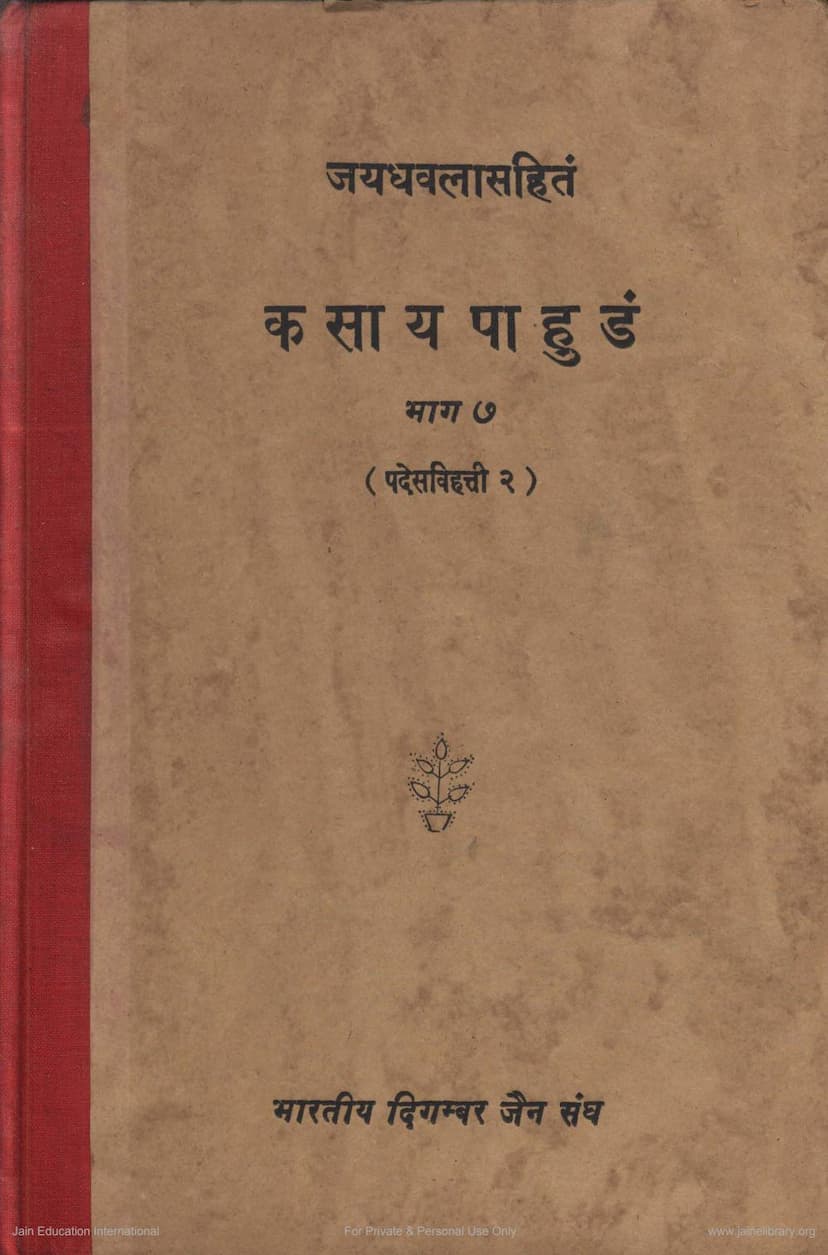Kasaypahudam Part 07
Added to library: September 2, 2025

Summary
This Jain text, "Kasaypahudam Part 07," with the commentary "Jayadhavalasahitam," authored by Gundharacharya, and edited by Fulchandra Jain Shastri and Kailashchandra Shastri, published by Bharatiya Digambar Jain Sangha, is a profound exploration of Jain philosophy, specifically focusing on the "Pradeshvibhaktika" (division of karmic particles) within the context of "Kashaya" (passions). This particular volume, Part 07 of the series, is the second part of the "Pradeshvibhaktika" section.
The text delves into the intricacies of how karmic particles (karma bandha) are distributed and experienced by souls (jiva) according to various factors. The summary below outlines the key concepts and topics discussed within this volume:
Core Concepts and Topics:
- Pradeshavibhaktika (प्रदेशविभक्ति): This is the central theme, dealing with the quantitative distribution and classification of karmic particles. It examines how karmic matter, upon bonding, is divided and allocated to the eight (or seven, depending on classification) types of karma. The text differentiates between the particles received at the moment of bonding and those that remain in the soul's state of existence (satta). This volume specifically focuses on the latter.
- Kashaya (कषाय): While the broader text of Kasaypahudam deals with Kashayas, this specific volume focuses on the Pradeshavibhaktika of the Mohaniya (deluding) karma, which is the root cause of all Kashayas. Mohaniya karma is described as having 28 sub-categories.
- Anuyogdwaras (अनुयोगद्वार): The text systematically analyzes Pradeshavibhaktika by employing various Anuyogdwaras, which are analytical categories or methods of inquiry. These include:
- Bhagabhaga (भागाभाग): The analysis of proportions or shares. This is discussed from two perspectives: Jivabhagabhaga (proportion related to souls) and Pradeshbhagabhaga (proportion related to karmic particles).
- Sarvapradesavibhaktika and Nosarva Pradesavibhaktika (सर्वप्रदेशविभक्ति / नोसर्वं प्रदेशविभक्ति): Dealing with the totality of particles versus less than the totality.
- Utkrishta, Anutkrishta, Jaghanya, Ajaghanya Pradesavibhaktika (उत्कृष्ट-अनुत्कृष्ट-जघन्य-अजघन्य प्रदेशविभक्ति): Examining the highest, lower than highest, lowest, and higher than lowest divisions of karmic particles.
- Sadipradeshvibhaktika and Anadipradeshvibhaktika (सादि-अनादि प्रदेशविभक्ति): Discussing whether the division has a beginning or is eternal.
- Dhruva and Adhruva Pradesavibhaktika (ध्रुव-अध्रुव प्रदेशविभक्ति): Whether the division is permanent or impermanent.
- Ownership (स्वामित्व): Identifying which soul (or type of soul) possesses the highest or lowest division of karmic particles.
- Time (काल): Analyzing the duration for which these divisions are experienced.
- Interim (अन्तर): Examining the time gap between the occurrences of these divisions.
- Bhanga Vichaya (भङ्गविचय): Exploring various permutations and combinations regarding the states of different souls in relation to these divisions.
- Parimana (परिमाण): Determining the quantity or number of souls that experience these divisions.
- Kshetra (क्षेत्र): Analyzing the spatial extent associated with these divisions.
- Sparshana (स्पर्शन): Examining the touch or contact with the karmic particles.
- Sannikarsa (सन्निकर्ष): Discussing the proximity or relationship between different types of karma in relation to these divisions.
- Bhava (भाव): Considering the mental states (like Oudaika - resulting from passions) associated with these divisions.
- Alpbahutva (अल्पबहुत्व): Comparing the subtle quantitative differences between various divisions and their possessors.
- Upakrama (उपोद्घात): The text begins with an introductory section, likely including Mangalacharan (auspicious invocation) and briefly touching upon the previous topics (Prakrutivibhaktika, Sthitivibhaktika, Anubhavavibhaktika) before commencing the discussion on Pradeshvibhaktika.
- Chulikas (चूलिका): The volume incorporates "Chulikas" or supplementary sections to provide further detail on specific aspects. Mentioned are:
- Zheenajheena Chulika (झीनाझीनचूलिका): Dealing with concepts of "heen" (deficient/reduced) and "ajeen" (not reduced/complete) in relation to karmic particles, possibly concerning their capacity for alteration (utkarshana, apakarshana, sankramana, udaya).
- Sthitig Chulika (स्थितिगचूलिका): Focusing on the concept of "sthiti" (duration) in relation to karmic particles, possibly discussing different states of attainment related to duration.
- Jayadhavala Commentary: The text is accompanied by the highly revered Jayadhavala commentary by Virasenacharya, which provides an extensive explanation of the original Kashayapahuda text. The editors have worked with the Churnisutra (a concise explanatory text) composed by Yativrishabhacharya to synthesize the commentary.
Structure and Content:
The book systematically moves through the various Anuyogdwaras, applying them to the Mohaniya karma (and sometimes generalizing to all karmas or specific other karmas like Krodha, Mana, Maya, Lobha, Vedas, and Darshanamohaniya) to analyze Pradeshavibhaktika. It elaborates on:
- Proportionate Distribution (Bhagabhaga): How the total karmic matter is divided among the eight types of karma and then further among the sub-types of Mohaniya karma.
- Qualitative Divisions (Utkrishta, etc.): Analyzing the highest, lowest, and intermediate degrees of karmic particle division within a soul's experience.
- Temporal Aspects (Kala and Antara): How long these divisions last and the intervals between them, often considering different states of existence (hell-dwellers, animals, humans, celestial beings).
- Ownership and Soul Types (Swami): Identifying which soul types are primarily associated with these divisions, often linking them to specific stages of spiritual progress (e.g., Gunsthitas, Kshepakas).
- Combinatorial Analysis (Bhanga Vichaya): Exploring how these divisions manifest in various combinations across different souls and karmic states.
- Spatial and Temporal Aspects (Kshetra, Sparshana, Kala,antara): Relating these divisions to the soul's location, its interaction with the environment, the time periods involved, and the gaps between these experiences.
- The Role of Kashayas: The text implicitly or explicitly connects the intensity and type of Pradeshavibhaktika to the specific Kashayas (anger, pride, deceit, greed) that characterize the Mohaniya karma.
Overall Significance:
This volume is a highly technical and detailed exposition of Jain Karma theory. It demonstrates the rigorous analytical framework employed in Digambara Jain philosophy to understand the subtle workings of karma. The editors' effort in compiling and presenting this complex text, including the Churnisutra and the original commentary, is crucial for scholars and practitioners seeking to understand the deep philosophical underpinnings of Jainism, particularly concerning the accumulation, division, and experience of karma. The text is intended for private and personal use, indicating its specialized nature within Jainological studies.